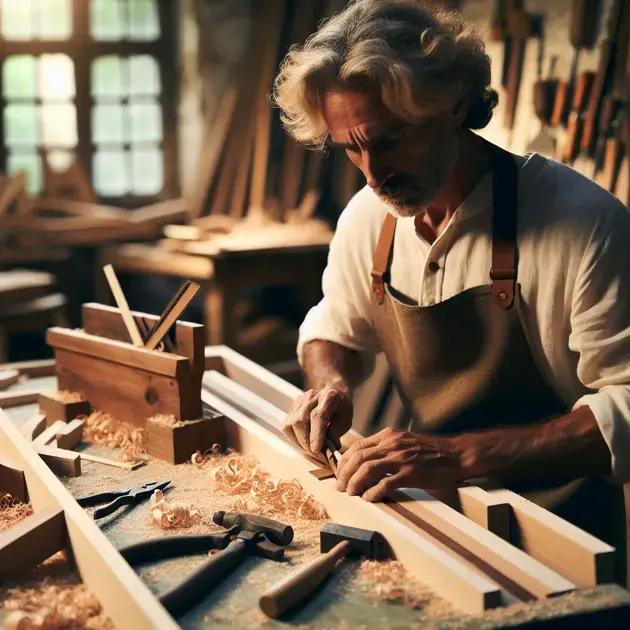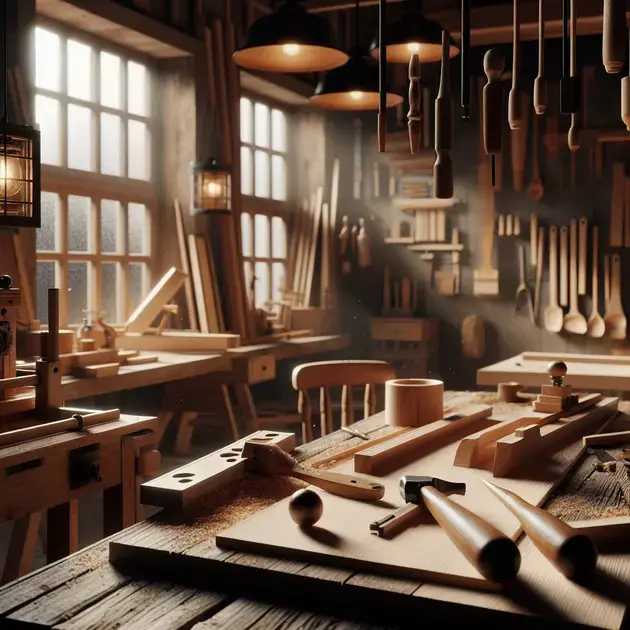When it comes to crafting beautiful projects, mastering woodworking techniques is essential. From intricate joinery to the art of finishing, these skills are crucial for creating high-quality pieces that stand the test of time.
With the rise of DIY culture and the increasing popularity of handmade items, woodworking has experienced a resurgence in recent years. Learning and perfecting these techniques can not only help you create stunning projects, but also provide a sense of satisfaction and accomplishment.

Essential Woodworking Skills for Beautiful Projects
Woodworking projects can be truly rewarding when you have the essential skills to bring your ideas to life. To create beautiful projects, it’s important to start with a solid foundation of woodworking skills. Here are some key skills that are essential for woodworking projects:
1. Measurement and Layout Techniques:
Accurate measurements are crucial in woodworking to ensure that your pieces fit together perfectly. Use tools like a tape measure, combination square, and marking gauge to measure and mark your wood accurately. Apps like “Woodworking Toolkit” offer various measurement and layout features to help you work with precision.
2. Proper Tool Handling:
Knowing how to properly handle and use your woodworking tools is essential for safety and efficiency. Whether you’re using a circular saw, chisel, or hand plane, make sure to follow the manufacturer’s instructions and practice good tool maintenance. Websites like “Fine Woodworking” provide step-by-step guides on tool handling techniques.
3. Understanding Wood Grain:
Understanding the grain pattern of different wood species is key to creating visually appealing projects. Grain direction can affect the strength and appearance of your work, so take the time to identify and work with the grain properly. Online resources like “The Wood Database” offer detailed information on wood species and grain patterns.
4. Joinery Techniques:
Mastering various joinery techniques is essential for creating strong and durable woodworking projects. Learn how to create basic joints like butt joints and dado joints, as well as more intricate joints like dovetails and mortise and tenon joints. Apps like “Woodworking Joints” provide tutorials and guides on different joinery techniques.
5. Finishing Skills:
The final finish applied to your woodworking project can make a huge difference in its overall appearance and longevity. Whether you prefer a natural oil finish or a glossy varnish, mastering the art of finishing is essential. Websites like “The Spruce Crafts” offer tutorials and tips on various finishing techniques.
Mastering Intricate Joinery Techniques
Joinery is a fundamental aspect of woodworking that involves joining pieces of wood together to create a strong and stable structure. Mastering intricate joinery techniques can take your woodworking projects to the next level. Here are some key joinery techniques to master:
1. Dovetail Joints:
Dovetail joints are known for their strength and decorative appeal. Learning how to accurately cut and fit dovetails will enhance the quality of your work. Websites like “Popular Woodworking” offer detailed tutorials on creating dovetail joints by hand.
2. Mortise and Tenon Joints:
Mortise and tenon joints are commonly used in furniture making for their durability and stability. Understanding how to create clean and precise mortise and tenon joints is essential for advanced woodworking projects. Apps like “Woodworking Techniques” provide step-by-step guides on mastering this technique.
3. Box Joints:
Box joints, also known as finger joints, are great for joining corners of boxes and drawers. Mastering the technique of creating tight-fitting box joints requires practice and precision. Websites like “Rockler Woodworking” offer tutorials and jigs for cutting perfect box joints.
4. Half-Lap Joints:
Half-lap joints are strong and simple to create, making them ideal for joining pieces of wood at right angles. Learning how to cut clean half-lap joints will expand your joinery skills. Online forums like “WoodNet Forums” provide discussions and tips on mastering half-lap joints.
5. Through-Tenon Joints:
Through-tenon joints are visually striking and strong, making them a popular choice for fine woodworking projects. Understanding how to layout, cut, and fit through-tenon joints will elevate the craftsmanship of your work. Books like “The Complete Manual of Woodworking” offer in-depth guidance on creating through-tenon joints.
The Art of Finishing: A Key to High-Quality Woodworking
The finishing process is where woodworking projects truly come to life, enhancing the natural beauty of the wood and providing protection for years to come. Mastering the art of finishing is essential for achieving high-quality results. Here are some key steps to master the art of finishing:
1. Surface Preparation:
Proper surface preparation is crucial for a flawless finish. Sand the wood surface starting with coarse grit sandpaper and gradually progress to fine grit for a smooth finish. Websites like “Wood Magazine” offer tips on surface preparation techniques for different wood species.
2. Stain Application:
Staining wood can enhance its color and add depth to the grain. Choose a stain that complements the wood species and apply it evenly with a brush or cloth. Apps like “Minwax Stain Assistant” provide staining guides and color options for different wood types.
3. Sealant and Topcoat:Applying a sealant and topcoat is essential to protect the wood from moisture, UV rays, and wear. Choose a durable topcoat like polyurethane or lacquer and apply multiple thin coats for a professional finish. Online tutorials from “Woodworkers Guild of America” demonstrate proper sealant and topcoat application techniques.
4. Sanding Between Coats:
Sanding between coats of finish helps achieve a smooth and level surface. Use fine grit sandpaper or a sanding block to lightly sand the wood between each coat of finish. Websites like “Family Handyman” provide tips on sanding techniques for a flawless finish.
5. Final Buffing and Polishing:
To achieve a truly high-quality finish, consider buffing and polishing the final coat of finish. Use a fine abrasive pad or polishing compound to bring out the shine and smoothness of the wood surface. Online forums like “Sawmill Creek” offer discussions on buffing and polishing techniques for woodworking projects.

Advanced Wood Carving Techniques
In order to master advanced wood carving techniques, it is essential to start with the basics and gradually progress to more intricate methods. One key technique that can elevate your woodworking skills is relief carving, which involves carving designs into the surface of the wood to create a three-dimensional effect. To achieve perfect results with relief carving, it is important to use sharp carving tools and work slowly and carefully to avoid any mistakes.
Another advanced wood carving technique to explore is chip carving, which involves removing small chips of wood to create intricate patterns and designs. This technique requires precision and attention to detail, as even the slightest mistake can alter the final look of the carving. It is important to practice chip carving on scrap wood before attempting it on your final project.
One highly advanced wood carving technique that requires a high level of skill is whittling, which involves carving wood with a knife to create intricate shapes and designs. Whittling is a delicate and time-consuming process that requires patience and practice to master. To achieve perfect wood joints in whittling, it is crucial to use a sharp knife and work slowly and methodically.
Overall, mastering advanced wood carving techniques takes time, patience, and dedication. By practicing regularly and seeking guidance from experienced woodworkers, you can enhance your woodworking skills and create beautiful, intricate carvings that showcase your talent and creativity.
Achieving Perfect Wood Joints
Creating perfect wood joints is essential for ensuring the structural integrity and overall quality of your woodworking projects. One key step in achieving perfect wood joints is to properly prepare the wood surfaces by ensuring they are clean, smooth, and free of any imperfections. This will help the joints fit together snugly and securely.
Another important technique for achieving perfect wood joints is to use the right type of joinery method for the project at hand. Common joinery methods include dovetail joints, mortise and tenon joints, and finger joints, each of which offers unique strength and aesthetic benefits. Carefully selecting the appropriate joinery method will help ensure a strong and durable wood joint.
When assembling wood joints, it is crucial to use high-quality woodworking glue that is specifically designed for the type of wood being used. Applying the right amount of glue and clamping the joints tightly together will help create a strong bond that will withstand the test of time.
To achieve perfect wood joints, it is important to practice precision and accuracy in your woodworking techniques. Taking the time to measure and cut the wood accurately, as well as paying attention to detail during assembly, will result in seamless and flawless wood joints that enhance the overall quality of your woodworking projects.
Enhancing Your Woodworking Skills
To enhance your woodworking skills and take your craft to the next level, it is important to continuously seek new challenges and opportunities for growth. One way to enhance your woodworking skills is to experiment with different wood species and types to expand your knowledge and understanding of how different woods behave and respond to various woodworking techniques.
Another valuable approach to enhancing your woodworking skills is to learn from experienced woodworkers and take advantage of educational resources such as woodworking classes, workshops, and online tutorials. By studying under the guidance of skilled professionals and actively seeking out new learning opportunities, you can gain valuable insights and techniques to improve your woodworking craft.
Practicing regularly and dedicating time to honing your woodworking skills is essential for growth and improvement. Whether it’s carving, joinery, or finishing techniques, consistent practice and a commitment to excellence will help you develop a strong foundation of skills and expertise in woodworking.
Finally, don’t be afraid to push the boundaries of your creativity and take on challenging projects that push your skills to new heights. By stepping outside of your comfort zone and tackling complex woodworking projects, you can unlock new levels of skill and creativity that will elevate your woodworking abilities to new heights.
Conclusion
Mastering advanced wood carving techniques requires starting with the basics and gradually progressing to more intricate methods. Techniques like relief carving, chip carving, and whittling demand precision, patience, and practice to achieve impeccable results. These techniques, when honed with sharp tools and careful workmanship, can elevate your woodworking skills to new heights, allowing you to create intricate and three-dimensional designs that showcase your talent and creativity.
When it comes to achieving perfect wood joints, meticulous preparation of wood surfaces, choosing the right joinery method, and using high-quality woodworking glue are essential steps. By focusing on precision and attention to detail during assembly, you can create seamless and flawless wood joints that enhance the structural integrity and overall quality of your woodworking projects.
To enhance your woodworking skills further, it is crucial to continuously seek new challenges and learning opportunities. Experimenting with different wood species, learning from experienced woodworkers, and dedicating time to practice and hone your techniques will help you develop a strong foundation of skills in carving, joinery, and finishing. Don’t shy away from pushing your creativity and taking on challenging projects, as this will unlock new levels of skill and creativity, elevating your woodworking abilities to new horizons.